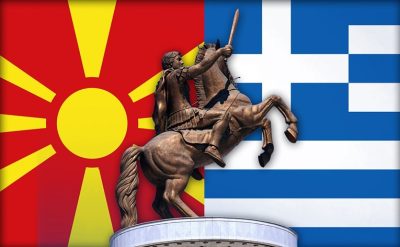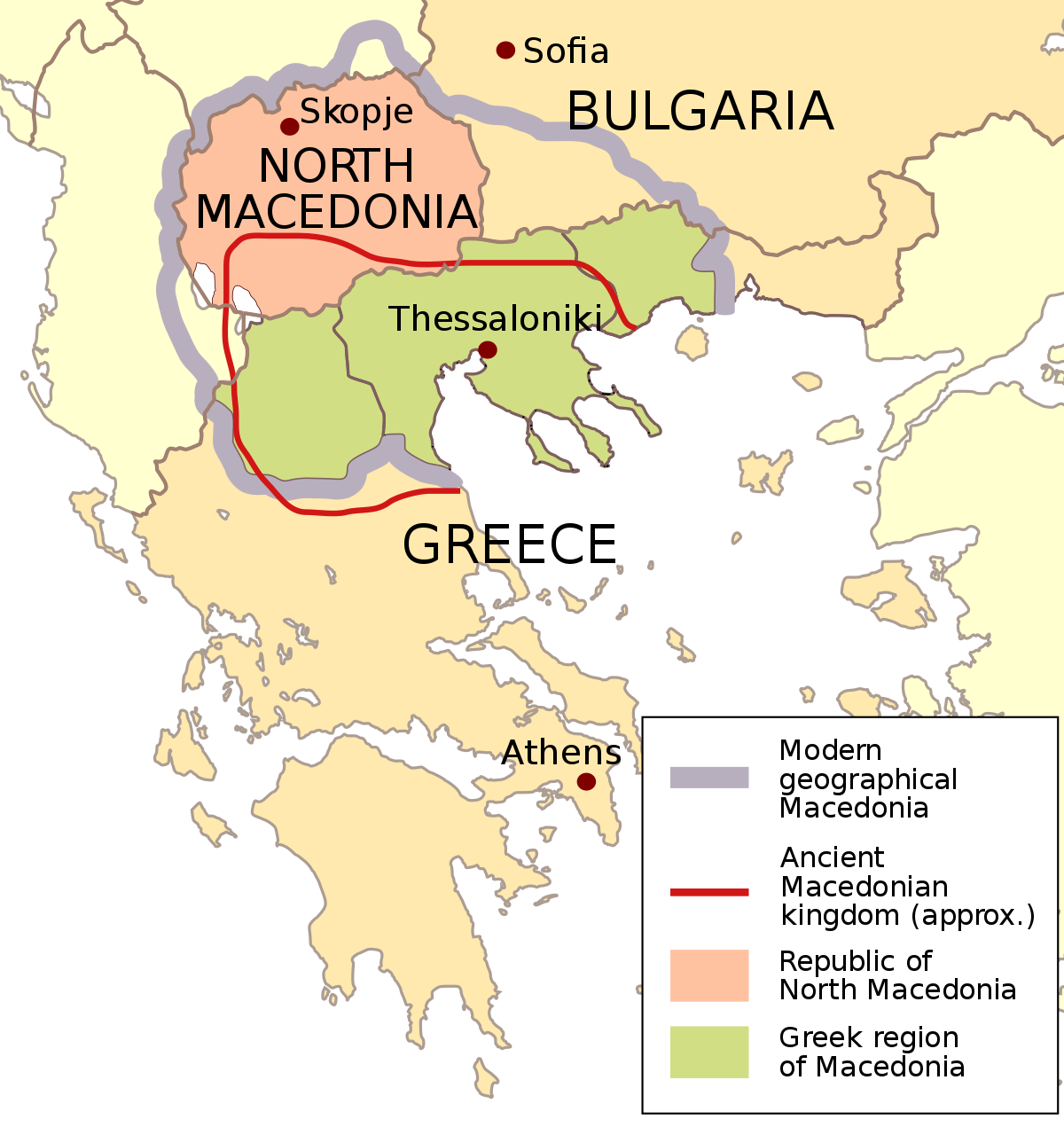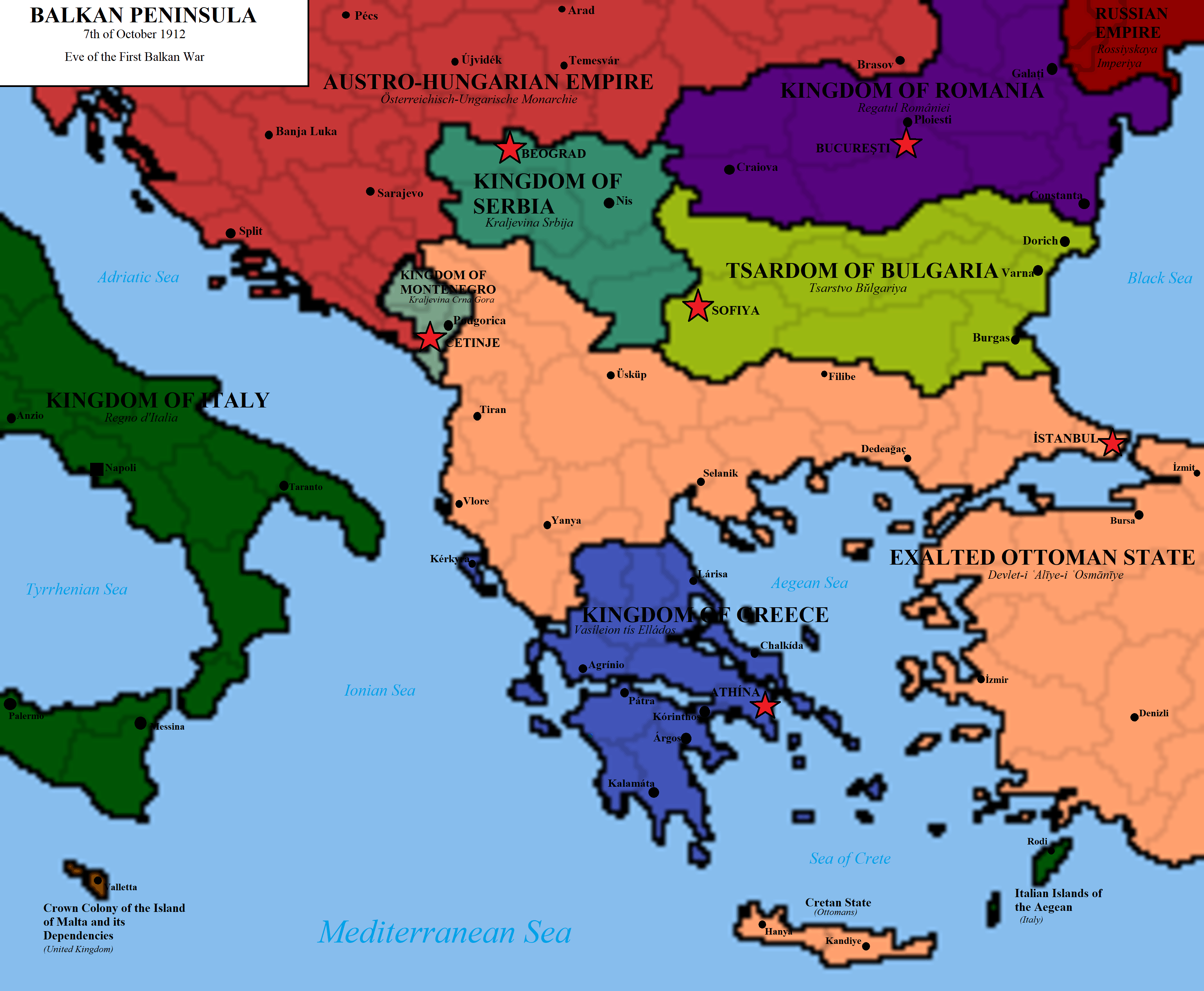History of the Balkans: Greece and Macedonia (1913-1993)

All Global Research articles can be read in 51 languages by activating the Translate Website button below the author’s name.
To receive Global Research’s Daily Newsletter (selected articles), click here.
Click the share button above to email/forward this article to your friends and colleagues. Follow us on Instagram and Twitter and subscribe to our Telegram Channel. Feel free to repost and share widely Global Research articles.
***
After the division of Macedonia in 1913 (according to the Bucharest Peace Treaty) neither Serbia, Bulgaria nor Greece recognized the existence of a Macedonian ethnolinguistic nation and, therefore, an assimilation policy of Macedonia’s Slavs was carried out by the state’s authorities of all those three countries.
Greece referred to Aegean Slavo-Macedonians as Slavophone Greeks or Macedoslavs (the region was and is today officially called “North Greece”), Serbia referred to Vardar Slavo-Macedonians as Serbs from “South Serbia” while for Bulgaria Pirin Slavo-Macedonians were Bulgarians.
Map Prior to World War I (1912)
Contemporary Map: Republic of North Macedonia and Greek region of Macedonia

When WWI started in 1914, Bulgaria sided with the Central Powers and in the fall of 1915 occupied Serbia’s part of Macedonia.[i] Vardar Macedonia was under Bulgaria’s occupation, together with East Serbia, until the fall of 1918 experiencing a full-scale brutal policy of Bulgarization and de-Serbization.
Nevertheless, with the defeat of Central Powers at the end of 1918, the 1913 partition of historical-geographic Macedonia was once again confirmed by the post-war peace treaties with one difference that Vardar Macedonia became after December 1st, 1918, incorporated into the new Kingdom of Serbs, Croats and Slovenes (renamed in 1929 into the Kingdom of Yugoslavia).[ii]
In the interwar period, a policy of assimilation of Macedonia’s Slavs continued by using different techniques and methods. For instance, in Greece, all Slavic personal and place names were Hellenized, and pieces of evidence of Slavic literacy were in many cases removed or destroyed.
In addition, in the 1920s, population exchanges took place between Greece and Bulgaria and Greece and Turkey. For instance, “over 1,200,000 Greeks left Turkey [from Asia Minor] of whom some 540,000 settled in Greek Macedonia along with approximately 100,000 more Greek refugees who settled there before 1920“.[iii]
Those Greek refugees who were transferred to Aegean Macedonia changed the ethnic breakdown of this region in favor of Hellenization and de-Slavization. Under the Ioannis Metaxas’ dictatorship (1936−1941)[iv] the position of all minorities in Greece worsened as the Greek government viewed the minorities as a danger to the state’s security but the repression of Slavic speakers in Greece was particularly severe. People were persecuted for expressing their national identity, like speaking their Slavic language.[v]
Over 5,000 Slavic speakers were interned from the border regions with the Kingdom of Yugoslavia[vi] and night schools served to teach adult Slavic speakers the Greek language.[vii] As a consequence, the number of people in Greek Macedonia with a sense of a Greek national identity increased substantially up to WWII.
Despite the assimilation efforts, attempts were made to change the situation and create an independent Macedonia. In 1925, Bulgaria’s-sponsored United Internal Macedonian Revolutionary Organization (IMRO) was founded in Vienna with the focal political task of freeing all alleged Macedonian territories and creating an independent Macedonian state that would later become united with Bulgaria.
Furthermore, in 1935 in Vardar Macedonia, a Macedonian National Movement organization (MANAPO) was created and in 1940 some democratic groups in Macedonia defined a political program for the national and social liberation of the country. In 1941, however, the Vardar and Aegean Macedonia were again occupied by Bulgaria, now a member of the Axis Powers. During WWII, Yugoslav communists established the Anti-Fascist Assembly of National Liberation of Macedonia (ASNOM), with the “unification of all Macedonian people” as its explicit goal.[viii]
Even though the Yugoslav partisan movement was not able to achieve this goal during the war, it succeeded in laying the foundation for the Yugoslav People’s Republic of Macedonia.[ix] In August 1944 Tito and the leaders of the Communist Party of Yugoslavia (KPJ) established the People’s Republic of Macedonia as a member of the new Yugoslav federation recognizing, therefore, the existence of a Macedonian nation and providing, at the same time, Yugoslav Macedonians with a national homeland.[x]
Yugoslav Macedonia became the territory to which many Slavic-speaking Macedonians from Greece fled after the Greek civil war of (1944−1949) in which the Greek Communist Party (KKE) and its military movement National People’s Liberation Army (ELAS) had promised equal rights to the Slavic-speaking population with the rest of Greece’s citizens and thereby got their firm political support.[xi] Nevertheless, due to the communist defeat, the rights of the Slavic-speaking population in Greece remained poor as they had not been recognized as an ethnic minority.
Due to fear of reprisal after the war, many Greek Slavic-Macedonians fled to Yugoslavia (Vardar Macedonia) and other East European countries while others emigrated to the Western countries (mainly to Canada and Australia), creating numerous Macedonian diaspora. Consequently, the number of Slavic speakers decreased once again in the region of Aegean Macedonia which became additionally Hellenized after 1949 similarly as it was after the population exchanges in the 1920s.
Some Slavic-speaking people, nevertheless, remained in Greek Macedonia after 1949 but an official number of them is unknown as they are not recorded by Greece’s authorities. Nevertheless, according to some unofficial sources, like Country Reports on Human Rights Practices for 1990, published by the US Department of State, at that time around 50,000 Slavic speakers lived in North Greece but a majority of them have not clear Slavic Macedonian identity or already accepted a Greek national identity. For instance, they identified themselves as Greeks and Macedonians or as Greek-Macedonians. A significant number of them, however, still retained a Slavic Macedonian national identity.
Since Greece became an EU member state in 1981, a number of Slavic speakers from Greece saw a great opportunity to promulgate their requirement for official recognition of Slavic Macedonians in Greece as an ethnic minority and, therefore, became politically active in order to draw political attention to the poor human rights situation of their compatriots in Greece. They seek recognition by the Greek government of the existence of a Macedonian minority in Greece and strive for the repeal of several laws which, according to their opinion, discriminate against Slavic Macedonians.
In 1982, for instance, a law was passed that ceased to recognize university degrees obtained in Yugoslav Macedonia on the grounds that the Macedonian language was not internationally recognized. They also claimed that the law on the general amnesty under which political refugees who left Greece after the civil war in the 1940s could return to Greece and reclaim their properties discriminates against Slavic Macedonians as the law is only applied to the people who were “Greek by birth” and, therefore, is not valid for Slavic speaking refugees who do not want to declare themselves to be Greeks.
Further, they want Macedonians in Greece to have the right to attend church services in Macedonian, to receive primary and secondary education in their native language, and to publish newspapers and broadcast radio and television programs in Macedonian as well.[xii] It is, however, debatable whether the Macedonian minority group is numerically strong enough to create, for instance, separate educational institutions, as according to international standards, a minority population needs to be sufficiently numerous for such demand to be justified.[xiii]
The emigration of a significant number of Slavic Macedonians out of Greece was not only a consequence of the Greek civil war but was also caused by a Greek anti-communist sentiment, which was translated into a feeling of the threat coming from neighboring socialist Yugoslavia as in Greek eyes Yugoslav authorities established the People’s Republic of Macedonia in order to gain more international support for Yugoslavia.
In essence, by the establishment of a constituent Republic of Macedonia within Yugoslavia, international recognition of Slavic Macedonians as a separate ethnic nation can be encouraged that would provoke international pressure for respecting Macedonian minority rights elsewhere (in Bulgaria and Greece), and thereby it could be used as an instrument of pressure in the realization of certain geopolitical calculations. Nevertheless, in reality, Greece denied the existence of a Macedonian minority on its own territory (Aegean Macedonia) and continued to strive for a good and close relationship with the Yugoslav government in the hope that it would restrain Macedonian irredentism.[xiv]
Greece not only denied the existence of a Macedonian population on its territory but also argued that Macedonian nationality was an artificial construction of Yugoslav leader Josip Broz Tito.[xv] According to Greek authorities, J. B. Tito and his Communist Party of Yugoslavia created a separate Macedonian republic for the Macedonian nation for the crucial reason of eliminating pro-Bulgarian sentiments of a larger part of the population of Yugoslav Macedonia.
In order to achieve this political goal, it was necessary to invent the essential elements of a new artificial nationality: a distinct standardized language with a new alphabet, independent church affiliation and organization, an easily identifiable name, and a rewritten national history. Greek authorities are of the opinion that the standardized Macedonian language in ex-Yugoslavia is a new literary language produced by Yugoslav linguists for political purposes and has nothing in common with a philological reality. It is based on Macedonia’s Prilep dialect, enriched by Serbian, Russian, and Polish contributions for the sake of developing remarkable differences with the neighboring Bulgarian language and, therefore, nationality.[xvi]
The establishment of an autonomous (and internationally not recognized) Macedonian Orthodox Church in 1967 (separated from the Serbian Orthodox Church) contributed to the affirmation of separate Macedonian existence and raised Macedonian ethnonational consciousness. Nevertheless, what went the most against the grain with Greece and was seen as the most visible measure to establish an artificial anti-Greek historical and political legitimacy of the new republic, was the use of the term “Macedonia” as the republic’s name. According to the Greek viewpoint, there were three crucial reasons for J. B. Tito to adopt this name:
- The name sharply contrasted with Bulgarian, Serbian, or Greek names and could, therefore, break the ties that Slavic speakers in Macedonia historically had with these countries and their nations.
- The designation was well-known to the population and thus suitable for a quick adaptation.
- Most importantly, with the name of Macedonia, all historical events and culture associated with a historical-geographical region of Macedonia could be easily appropriated by the Yugoslav Socialist Republic of Macedonia.[xvii]
Because of the feeling of territorial threat (due to the establishment of a Macedonian republic and strengthened by the fact that J. B. Tito offered military assistance to Greek guerrillas during the civil war), there were no diplomatic relations between Greece and Yugoslavia until 1951 and they were re-established primarily due to international pressure. The relations between the two countries, nevertheless, were not warm over the next years and in 1962 the Greek government unilaterally suspended the joint border agreement.[xviii]
During J. B. Tito’s rule (1945−1980), Macedonian nationalism had always been controlled by the central government but after he died on May 4th, 1980, the control was gradually loosened and Macedonian nationalism started to flourish as did all other nationalist sentiments within the country. When Yugoslavia began to collapse at the very beginning of the 1990s, a referendum was held on September 8th, 1991 on the future of Yugoslav Macedonia and a great majority of Macedonia’s citizens voted in favor of a completely sovereign and independent state of the Republic of Macedonia.[xix]
However, a new independent Balkan state as a neighbor to Greece from the beginning of its sovereign existence, provoked hostile political and economic sanctions by Athens from 1991 to 1993, due to the support by Slavic Macedonian nationalists of an idea to create a united Greater Macedonia.
*
Note to readers: Please click the share button above. Follow us on Instagram and Twitter and subscribe to our Telegram Channel. Feel free to repost and share widely Global Research articles.
Dr. Vladislav B. Sotirović is a former university professor in Vilnius, Lithuania. He is a Research Fellow at the Center for Geostrategic Studies. He is a regular contributor to Global Research.
Notes
[i] The Bulgarian occupation of parts of Serbia was based on the treaty signed between Bulgaria and Central Powers on September 6th, 1915 [Živko Avramovski, Ratni ciljevi Bugarske i Centralne sile 1914−1918, Beograd: Institut za savremenu istoriju, 1985, 150−171; Мира Радојевић, Љубодраг Димић, Србија у Великом рату 1914−1918. Кратка историја, Београд: Српска књижевна задруга−Београдски форум за свет равноправних, 2014, 170]. According to the secret Treaty of Sofia, signed on September 6th, 1915, Bulgaria got whole Vardar Macedonia, East Serbia up to Morava River, Toplica region, and East Kosovo. That was almost 59% out of total territory of pre-war Serbia [Андреј Митровић, „Први светски рат“, Прекретнице новије српске историје, Крагујевац−Лицеум, 1995, 83].
[ii] An official proclamation of Kingdom of Serbs, Croats and Slovenes was done in Belgrade on December 1st, 1918. The text of the proclamation is published in English in [Snežana Trifunovska, Yugoslavia Through Documents: From Its Creation to Its Dissolution, Dordrecht−Boston−London: Martinus Nijhoff Publishers, 1994, 157−160].
[iii] Hugh Poulton, The Balkans: Minorities and States in Conflict, London: Minority Rights Publications, 1994, 176.
[iv] Ioannis Metaxas (1871−1941) was a dictator of Greece from 1936 to 1941. Dictatorial position enabled him to crush hated political situation in Greece, reserving particular animosity for the communists. I. Metaxas created the notion of the „Third Hellenic Civilization“ that was a political attempt to combine the values of the ancient, pagan with those of the medieval, Christian Greek civilizations. He died in January 1941, two months before German invasion of Greece [Richard Clogg, A Concise History of Greece, Cambridge: Cambridge University Press, 1992, 218; Bernd J. Fišer (ed.), Balkanski diktatori: Diktatori i autoritarni vladari jugoistočne Evrope, Beograd: IPS−IP Prosveta, 2009, 191−227].
[v] Loring M. Danforth, “Claims to Macedonian Identity: The Macedonian Question and the Breakup of Yugoslavia”, Anthropology Today, Vol. 9, No. 4, 1993, 3−10.
[vi] Hugh Poulton, The Balkans: Minorities and States in Conflict, London: Minority Rights Publications, 1994, 177.
[vii] Историјата на Македонскиот народ, III, Скопје: НИП Нова Македонија, 1969, 271−275.
[viii] ASNOM (Antifašističko Sobranje narodnog oslobođenja Makedonije) was established on August 2nd, 1944 in the monastery of Prohor Pčinjski in Serbia nearby the border with today’s Macedonia. Macedonian communists, therefore, required after the war that the so-called „Ristovačka Macedonia“ with the monastery of Prohor Pčinjski should be annexed by the Socialist Republic of Macedonia [Branko Petranović, Istorija Jugoslavije 1918−1988, Druga knjiga, Beograd: NOLIT, 1988, 301].
[ix] Victor Roudometof, “Nationalism and Identity Politics in the Balkans: Greece and the Macedonian Question”, Journal of Modern Greek Studies, Vol. 14, No. 2, 1996, 253−301.
[x] An official name of a new country composed by six federal republics was a Federal People’s Republic of Yugoslavia that was proclaimed on November 29th, 1945 [Branislav Ilić, Vojislav Ćirković (eds.), Hronologija revolucionarne delatnosti Josipa Broza Tita, Beograd: NIP “Export-Press”, 1978, 102].
[xi] As in Yugoslavia and Albania, the task of Greek communists was to “ensure that they would be the only organized, armed force in the country when liberation came, in which case they would clearly be well placed to assume control of the levels of power” [Richard Clogg, A Concise History of Greece, Cambridge: Cambridge University Press, 1992, 132].
[xii] Loring M. Danforth, “Claims to Macedonian Identity: The Macedonian Question and the Breakup of Yugoslavia”, Anthropology Today, Vol. 9, No. 4, 1993, 3−10.
[xiii] About the rights of ethnic minorities, see [Will Kymlicka (ed.), The Rights of Minority Cultures, New York: Oxford University Press, 2000].
[xiv] Nikolaos Zahariadis, “Nationalism and Small-State Foreign Policy: The Greek Response to the Macedonian Issue”, Political Science Quarterly, Vol. 109, No. 4., 1994, 647. Another, more pragmatic reason for the keeping as good as political relations with Yugoslavia was the fact that Greek economy very much profited from Yugoslav (in fact, Serbian) tourists since 1974 onward.
[xv] In contemporary Serbian historiography, there is a great dispute about how many personalities had a nickname of Tito. The first Tito was, anyway, half Croat and half Slovenian but Tito who was in power after WWII was either second or third. On this issue, see [Vladan Dinić, Tito (ni)je Tito. Konačna istina, Beograd: Novmark, 2013]. One of the best historiographical biographies of Tito is [Перо симић, Тито. Феномен 20. века, Треће допуњено издање, Београд: ЈП Службени гласник, 2011]. According to the official report by Belgrade police on December 13th, 1943, a leader of Yugoslav partisans and Communist Party of Yugoslavia, Josip Broz Tito, was „speaking corrupted Serbian language which was similar to Kajkavian“ (i.e., Croatian-Slovenian) [Перо Симић, Звонимир Деспот (eds.), Тито: Строго поверљиво. Архивски документи, Београд: ЈП Службени гласник, 2010, 130−131].
[xvi] Among all Balkan languages and mythologies about national identities founded on them, Albanian case is, probably, the most remarkable as “Albanian is said to be the surviving descendant of the ancient Illyrian language, although its lexicon is derived from languages belonging to other groups” [Stephen Barbour, Cathie Carmichael (eds.), Language and Nationalism in Europe, New York: Oxford University Press, 2000, 223].
[xvii] Nikolaos Zahariadis, “Nationalism and Small-State Foreign Policy: The Greek Response to the Macedonian Issue”, Political Science Quarterly, Vol. 109, No. 4., 1994, 647.
[xviii] Ibid.
[xix] Loring M. Danforth, “Claims to Macedonian Identity: The Macedonian Question and the Breakup of Yugoslavia”, Anthropology Today, Vol. 9, No. 4, 1993, 3−10.


